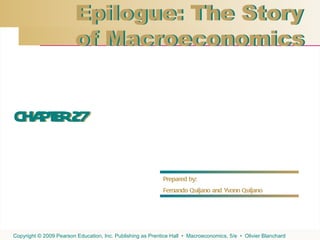Ch27 5e
•Als PPT, PDF herunterladen•
1 gefällt mir•3,180 views
- The document discusses the history and evolution of macroeconomic thought from Keynes' work in the 1930s establishing modern macroeconomics to recent developments. - It describes the neoclassical synthesis of the 1950s which integrated Keynesian and classical ideas and the influential IS-LM model. - In the 1970s, the rational expectations critique challenged Keynesian models and assumptions, leading to new classical, new Keynesian, and new growth theory work. - By the late 1980s, these schools of thought had integrated rational expectations and nominal rigidities into models still used today like New Keynesian and DSGE models.
Melden
Teilen
Melden
Teilen

Empfohlen
Empfohlen
Weitere ähnliche Inhalte
Was ist angesagt?
Was ist angesagt? (20)
The Heckscher-Ohlin theory of international trade/ Modern International Trade...

The Heckscher-Ohlin theory of international trade/ Modern International Trade...
Modern theory of factor endowment heckscher ohilin theory

Modern theory of factor endowment heckscher ohilin theory
Factor endowments and the heckscher ohlin theory (chapter 5)

Factor endowments and the heckscher ohlin theory (chapter 5)
Kuznets Hypothesis Economic Growth and Income Inequality

Kuznets Hypothesis Economic Growth and Income Inequality
Ähnlich wie Ch27 5e
Ähnlich wie Ch27 5e (20)
Unit 1 (Introduction to Macro Economics) by Dr. Abhay Singh Chauhan

Unit 1 (Introduction to Macro Economics) by Dr. Abhay Singh Chauhan
Module 35 history and alternative views of macroeconomics

Module 35 history and alternative views of macroeconomics
What led to the demise of ‘conventional Keynesian wisdom’ in the mid.pdf

What led to the demise of ‘conventional Keynesian wisdom’ in the mid.pdf
MonetarismName of the studentName of the ProfessorNa.docx

MonetarismName of the studentName of the ProfessorNa.docx
Principle_of_effective_demand_-key_to_the_General_Theory (1).doc

Principle_of_effective_demand_-key_to_the_General_Theory (1).doc
Population Dynamics and Nonlinearities in Economic Systems 

Population Dynamics and Nonlinearities in Economic Systems
Kürzlich hochgeladen
This presentation was provided by William Mattingly of the Smithsonian Institution, during the third segment of the NISO training series "AI & Prompt Design." Session Three: Beginning Conversations, was held on April 18, 2024.Mattingly "AI & Prompt Design: The Basics of Prompt Design"

Mattingly "AI & Prompt Design: The Basics of Prompt Design"National Information Standards Organization (NISO)
Kürzlich hochgeladen (20)
Unit-V; Pricing (Pharma Marketing Management).pptx

Unit-V; Pricing (Pharma Marketing Management).pptx
This PowerPoint helps students to consider the concept of infinity.

This PowerPoint helps students to consider the concept of infinity.
Presentation by Andreas Schleicher Tackling the School Absenteeism Crisis 30 ...

Presentation by Andreas Schleicher Tackling the School Absenteeism Crisis 30 ...
Russian Escort Service in Delhi 11k Hotel Foreigner Russian Call Girls in Delhi

Russian Escort Service in Delhi 11k Hotel Foreigner Russian Call Girls in Delhi
Mattingly "AI & Prompt Design: The Basics of Prompt Design"

Mattingly "AI & Prompt Design: The Basics of Prompt Design"
Unit-IV; Professional Sales Representative (PSR).pptx

Unit-IV; Professional Sales Representative (PSR).pptx
Measures of Central Tendency: Mean, Median and Mode

Measures of Central Tendency: Mean, Median and Mode
Z Score,T Score, Percential Rank and Box Plot Graph

Z Score,T Score, Percential Rank and Box Plot Graph
Ch27 5e
- 8. Lawrence Klein developed the first U.S. macroeconomic model in the early 1950s. The model was an extended IS relation, with 16 equations. 27-2 The Neoclassical Synthesis Progress on All Fronts Macroeconometric Models Klein
- 12. 27-2 The Neoclassical Synthesis The Phillips Curve Keynesians versus Monetarists The Phillips curve had become part of the Neoclassical synthesis, but Milton Friedman and Edmund Phelps argued that the apparent trade-off between unemployment and inflation would quickly vanish if policy makers actually tried to exploit it. By the mid 1970s, the consensus was that there was no long-run trade off between inflation and unemployment. Phelps
- 22. 27-3 The Rational Expectations Critique The Integration of Rational Expectations Wage and Price Setting Stanley Fischer and John Taylor showed that the adjustment of prices and wages in response to changes in unemployment can be slow even under rational expectations. They pointed to the staggering of both wage and price decisions, and explained how a slow return of output to the natural level can be consistent with rational expectations in the labor market. Fischer Taylor
- 24. 27-4 Recent Developments Since the late 1980s, three groups have dominated the research headlines: the new classicals, the new Keynesians, and the new growth theorists.
- 29. 27-4 Recent Developments New Growth Theory One example of some of the advances economists have made is on the work of Philippe Aghion and Peter Howitt. They have developed a theme first explored by Joseph Schumpeter in the 1930s, the notion that growth is a process of creative destruction , in which new products are constantly introduced, making old ones obsolete. Aghion Howitt
- 30. 27-4 Recent Developments New Growth Theory Andrei Shleifer (from Harvard University) has explored the role of different legal systems in affecting the organization of the economy, from financial markets to labor markets, and, through these channels, the effects of legal systems on growth. Daron Acemoglu (from MIT) has explored how to go from correlations between institutions and growth— democratic countries are on average richer—to causality from institutions to growth Shleifer Acemoglu
- 31. 27-4 Recent Developments New Growth Theory Woodford, Gali, and a number of co-authors have developed a model, known as the New-Keynesian model, that embodies utility and profit maximization, rational expectations, and nominal rigidities. This model has proven extremely useful and influential in the redesign of monetary policy. It has also led to the development of a class of larger models that build on its simple structure, but allow for a longer menu of imperfections and thus must be solved numerically. These models, which are now used in most central banks, are known as dynamic stochastic general equilibrium (DSGE) models. Woodford Gali